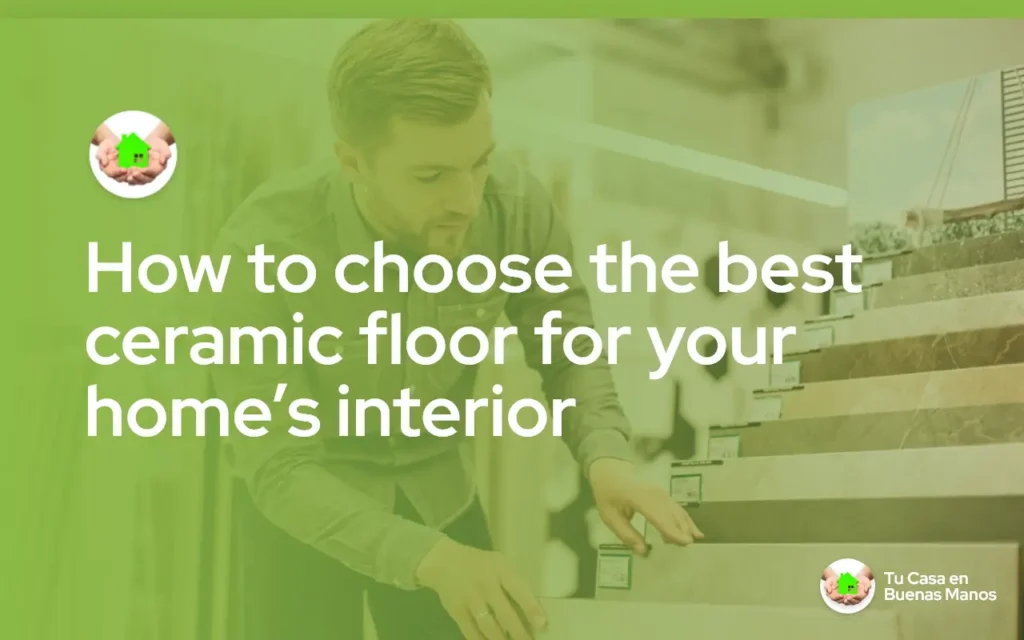Choosing the right floor for your home’s interior is no small task. At our construction and renovation company, we advise clients every day who face this decision. Ceramic is one of the most versatile and durable options, but to truly get it right, you need to look beyond design alone.
From each room’s function to the material’s resistance, plus technical and aesthetic aspects, here’s everything you need to make a confident choice—straight from people who are on-site, every day.
Why ceramic is a great choice for interiors
Ceramic stands out for its resistance, low maintenance, and countless aesthetic possibilities. It’s ideal indoors thanks to its durability, easy cleaning, and its ability to match any style—from rustic to ultra‑modern.
In high‑use areas like kitchens or hallways, ceramic handles foot traffic, splashes, and temperature changes with ease. In bedrooms, it adds elegance without sacrificing function. It’s also cost‑effective per square meter compared to materials like wood or natural stone.
Pro tip: if you want a long‑term, practical solution, ceramic delivers years of worry‑free use with minimal upkeep.
Define each room before choosing
Not all rooms need the same ceramic. In bathrooms and kitchens, for example, moisture resistance and anti‑slip safety are essential. In a bedroom, you can prioritize visual warmth or comfort underfoot.
Day to day, we assess the specific use of each area with clients. For bathrooms we recommend porcelain with anti‑slip type 3; for kitchens, type 2 that balances resistance and easy cleaning. In hallways or entries, go for porcelain with PEI 4 or higher to handle constant traffic.
Pro tip: match the floor to the room’s function. Don’t use the same material everywhere if conditions vary from one room to another.
Porcelain or red‑body: which suits you best?
This is one of the most common questions. Porcelain is dense, low‑porosity, and highly resistant—great for humid areas, heavy traffic, or where impacts are likely. Red‑body tiles are more economical and fine for bedrooms or low‑use rooms.
A quick way to tell them apart? Check the underside: white means porcelain; red means red‑body.
Beyond type, consider thickness—thicker tiles resist better. And always use the right adhesive for each one. The wrong choice can lead to tiles loosening or cracking over time.
Pro tip: invest in porcelain for critical areas. Long‑term, it’s more cost‑effective.
Design, finishes, and formats: choosing with style
Ceramic lets you create unique atmospheres. Choose finishes that mimic wood, stone, marble, or concrete. Format matters a lot for spatial perception: large pieces create a sense of openness and reduce joints; small formats shine in tight or angled spaces.
Layout also matters. Horizontal layouts make spaces feel wider; vertical layouts add a feeling of height.
On our projects, we suggest picking the grout color slightly darker than the tile tone to hide everyday dust and wear.
Pro tip: don’t underestimate design power. Format and orientation can transform how a room feels.
Safety and durability: the hidden essentials
Beyond looks, a few technical points guarantee a great experience. One is anti‑slip rating. You’ll typically find three levels:
- Type 1: dry zones (bedrooms, living rooms)
- Type 2: humid zones with moderate traffic (kitchens)
- Type 3: humid zones with higher risk (bathrooms)
Also check the PEI rating for wear resistance. PEI 3 is fine for calm areas; for hallways or entries, choose PEI 4 or 5.
Pro tip: make sure the floor is safe, especially if you have children or elderly people at home.
The finishing touch: details that elevate the result
A good floor needs proper trims. Baseboards protect walls and create a crisp finish. Stair nosings and edge trims are essential for steps or level changes. Well‑chosen grout improves aesthetics and avoids moisture issues.
Another key point is the thin‑set (adhesive). Using the wrong one can cause debonding. In our company, we always use the manufacturer‑recommended adhesive for the tile type and substrate.
Pro tip: small details make the difference between a merely okay floor and an impeccable one.
Quick Reference: Best Ceramic Floor Options by Room
Quick Reference: Best Ceramic Floor Options by Room
| Room | Tile type | Ideal finish | Key recommendations |
|---|---|---|---|
| Kitchen | Porcelain | Anti-slip type 2 | PEI 4+, easy to clean, mid-tone |
| Bathroom | Porcelain | Anti-slip type 3 | Darker grout, proper waterproofing |
| Bedroom | Red-body or porcelain | Smooth or wood-look | Large format, warm look |
| Hallway/Entry | Porcelain | PEI 4 minimum | High wear resistance, durable format |
| Kids’ room | Porcelain, thicker | Anti-slip type 2 | Impact resistance, safety prioritized |
How much to buy? Avoid common mistakes
A very common mistake is underestimating quantity. We always recommend ordering at least 10% extra. You’ll use it for cuts, adjustments, and to keep spare pieces.
Also check that every box has the same shade and caliber. Small differences can be very noticeable once installed.
Pro tip: keep at least one unopened box. It can save you later if you need a repair.
- Ready-to-Rent on the coast: how to renovate to rent better with less maintenance - October 20, 2025
- What renovation increases resale value the most in apartments near the coa - October 19, 2025
- How much does it cost to renovate a luxury bathroom? - September 16, 2025




